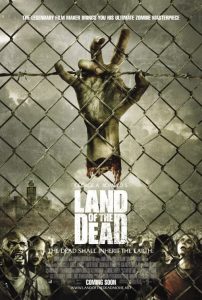 The good thing about a George Romero zombie movie is that you’ve got awesome social commentary if you go for that kind of thing, you’ve got zombie mayhem if you go for that kind of thing, both if you’re like me, and if you like zombies but hate social commentary, it’s not like you’ll notice.
The good thing about a George Romero zombie movie is that you’ve got awesome social commentary if you go for that kind of thing, you’ve got zombie mayhem if you go for that kind of thing, both if you’re like me, and if you like zombies but hate social commentary, it’s not like you’ll notice.
The bad thing about them is that for people who like social commentary but not so much with the zombies, you can never really convince them that a zombie movie can have intrinsic value. I (of course) mean here intrinsic value of the type that everyone recognizes in movies like Sophie’s Choice or Snow Falling on Cedars or bullstuff like that. The intrinsic zombie movie value of Land of the Dead, with its extensive gore, random zombie strippers (CORRECTION: random regular strippers), gratuitous undead attacks on lesbians, and senseless violence against midgets, well, it has all of that, too. But I’m talking about the Romero-style commentary you get in his zombie movies, the part that lets you see past the zombies and realize he could have made the exact same movie without ghoulish hordes, but was cool enough not to.
Is it my place to say what the themes were this time? Clearly, it is. The movie is set years or possibly decades after the original zombie outbreak; a few walled cities contain the vestiges of humanity, and the zombies cover the rest of the earth. The divide (social, intellectual, perhaps even moral) between zombie and human is rapidly narrowing from both directions. It reminded me a lot of I Am Legend, for whatever that’s worth. On top of the dark mirror motif, there’s some (perhaps meant to be relevant to the world of now?) extensive Circus Maximus keeps the citizens happy while the Huns rampage just outside the walls of Rome imagery going on. I think there’s something to be said for the idea that the two themes are intertwined, but then, I’m just a guy who types with two or three fingers, so what do I know?
Also, there were boobies.